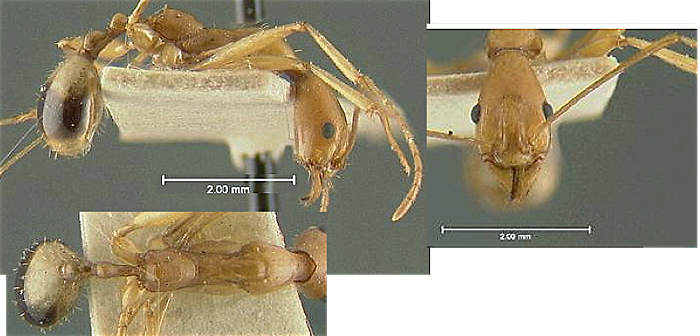SUBFAMILY MYRMICINAE - Genus Aphaenogaster Mayr
| The Ants
of Egypt SUBFAMILY MYRMICINAE - Genus Aphaenogaster Mayr |
Genus Aphaenogaster Mayr (1853b: 107)
Mayr's (1853b) genus description is at ![]()
In Myrmicinae: Pheidolini (Bolton, 1995: 20). Emery (1921f)
separated four subgenera, of which the following are relevant to Egypt
-
Deromyrma (Forel Emery - worker with the head elongated behind
into a distinct neck, sometimes extremely long (as in Madagascar
species); antennae slender, usually terminated in a weak four-segmented
club
Attomyrma - head not elongated behind; antennae terminating in a
four-segmented club much thicker than rest of the funiculus; basal
segment of gaster smooth or longitudinally striated.
See also Bondroit (1918: 155 ff, illustrated) ![]() . Bondroit separated Attomyrma Em.
as with legs solely with pubescence; whereas Aphaenogaster Mayr
had legs bristling with erect hairs.
. Bondroit separated Attomyrma Em.
as with legs solely with pubescence; whereas Aphaenogaster Mayr
had legs bristling with erect hairs.
He noted splendida as being yellowish red, with the propodeum
impressed between the spines; TL 5-6 mm.
A. syriaca was not separated, still being under gibbosa
- body colour at least brown; head matt; from Emery (1908c: 335) dark
reddish-yellow, with gaster brown, TL 4 mm.
Walker (1871) gave the queen of A. pallescens as black and shining, with the anterior head tawny; antennae, gaster and legs testaceous.
Egyptian species
Aphaenogaster sardoa cf foreli Cagniant - possibly = Pheidole fadli - see Wolf, K. 1915. Studien ueber palaearktische Formiciden. 1. Berichte des Naturwissenschaftlich-Medizinischen Veriens in Innsbruck, 35, 39-52
 |
Aphaenogaster (Attomyrma) splendida (Roger) |
 |
Aphaenogaster (Attomyrma) syriaca Emery |
| No images available |
Aphaenogaster pallescens Walker |
 |
Aphaenogaster (Deromyrma) phillipsi Wheeler & Mann |
|
©2005, 2006, 2008, 2009, 2015 -
Brian
Taylor CBiol FRSB FRES 11, Grazingfield, Wilford, Nottingham, NG11 7FN, U.K. |
href="aphaenogaster.htm"